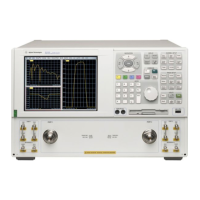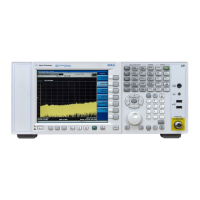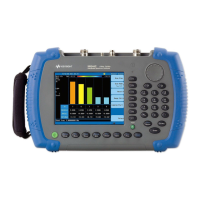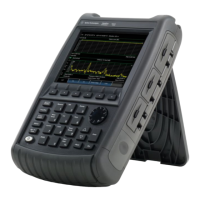Chapter 3 205
Mode
Return Loss
Mode
The Return Loss calibration is the same calibration as performed for the One Port
Insertion Loss and Distance to Fault (when it is performed with Frequency Range set to
manual) measurements. If you have already calibrated for any of these three
measurements, the calibration will apply to the other two measurements and “Calibrated”
(together with the frequency range over which the calibration was performed) will be
displayed on top left of the screen for all three.
The Distance to Fault calibration (when it is performed with Frequency Range set to Auto)
is only valid for other Distance to Fault measurements that are also performed with
Frequency Range set to Auto, and then only if the calibrated frequency range falls within
the previously calibrated frequency range.
If you have not previously performed a calibration, the word “Factory Calibration” appears
at the top left of the measurement screen.
It is important that you keep the calibration frequency range as close as possible to the
actual sweep frequencies you intend using for the measurement or measurements.
Calibrating over a large frequency range, such as >2
GHz, when you only intend measuring
over a much smaller frequency range, such as <10
MHz, will induce inaccuracies into your
results.
NOTE The Calibrate Start/Stop frequencies define the frequency range over
which the CALIBRATION will take place, and do NOT define the
frequency range over which the MEASUREMENT will be made.
If you plan to perform a combination of Return Loss measurement, One-Port Insertion
Loss measurement, and Distance to Fault measurements using a frequency range that you
will set manually, you can perform one calibration for all three measurements as long as
you calibrate over a frequency range that incorporates all three of your measurements, and
as long as your cables do not change. For this reason, if you are doing Distance to Fault
measurements (using a frequency range that you have set manually) as well as any type of
Insertion Loss measurement, Agilent recommends that you select your cable type before
performing calibrations. Press
Mode, Stimulus/Response, Meas, Distance to Fault,
Meas Setup, Cable Type to set the cable type.
The calibration remains valid until you do any one of the following:
• Set the Distance to Fault frequency range to Auto. Note that the calibration will become
valid again as soon as you switch from Auto back to Manual Frequency Range.
• Power off the spectrum analyzer
• Change the start frequency to a new value that lies below the start frequency of your
previous calibration
Mode Stimulus / Response
Key Path
FREQ/Channel, Calibrate
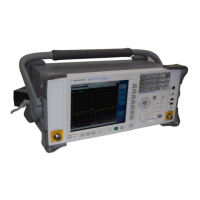
